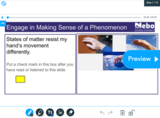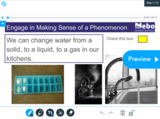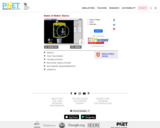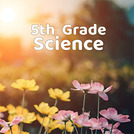
Google folder with Googles Slides and accompanying student journal files
- Subject:
- Professional Learning
- Science
- Material Type:
- Unit of Study
- Provider:
- Provo City School District
- Date Added:
- 10/14/2021

Google folder with Googles Slides and accompanying student journal files

This is a fifth-grade student science experience tied to SEEd standard 5.2.1. In this experience students investigate that matter is made of particles too small to be seen.
These experiences were designed to support students in engaging in science investigations with siblings and/or parents at home and then report back about what was discovered. They were created in a way that is easily adaptable for both online and printed formats. They are formatted to help students wonder about and investigate the science phenomena happening in the world around them. These experiences do not describe how students should write up and return work to their teacher. It is up to each teacher to adapt them to best meet student needs. When individualized by the teacher, a student could be asked to engage in one or more of these experiences a week and report back. This format aligns closely to the vision and expectation of the SEEd standards.

A lesson about air particles (Going 3D with GRC)

A set of lessons that covers the SEEd standards a set of lessons that covers all of 5.2 (Core Knowledge)

Students will obtain an introduction to mixtures and solutions.

This lesson plan utilizes filmmaking to solidify student understanding of scientific phenomena related to matter. While the plan is tied to 5th grade SEEd standards, it can be adapted to meet any SEEd standard at any grade level, particularly in upper elementary, middle school, and high school. (This resource's preview image was created by the author of this lesson plan.)

Student facing Nearpod lessons for the SEEdStoryLines. A free K-6 science curriculum written by teachers and based on both the 5E and GRC models. It is a student-centered curriculum that uses a storyline format to promote wonder, sensemaking, and problem solving. It includes both face-to-face and remote materials.

Student facing Nearpod lessons for the SEEdStoryLines. A free K-6 science curriculum written by teachers and based on both the 5E and GRC models. It is a student-centered curriculum that uses a storyline format to promote wonder, sensemaking, and problem solving. It includes both face-to-face and remote materials.

Student facing Nearpod lessons for the SEEdStoryLines. A free K-6 science curriculum written by teachers and based on both the 5E and GRC models. It is a student-centered curriculum that uses a storyline format to promote wonder, sensemaking, and problem solving. It includes both face-to-face and remote materials. This is an assessment at the end of the 4 episodes for the standard 5.2.1

This is an interactive, fifth-grade Nearpod lesson tied to SEEd standard 5.2.1. It guides students through information and activities about states of matter.
This resource is a student-ready, three-dimensional SEEd science lesson you can add to your Nearpod library. Many of the phenomena, text, and images come from UEN OER textbooks, Seedstorylines.org, ck12.org, and pixabay.com. Most videos are from youtube.com or pbslearningmedia.org. Many of the simulations were found at phet.colorado.edu, ck12.org, and pbslearningmedia.org. This lesson is unique to Nebo School District but was built with the help of many amazing ideas from teachers throughout Utah.

This is an interactive, fifth-grade Nearpod lesson tied to SEEd standard 5.2.1. It guides students through information and activities about states of matter.
This resource is a student-ready, three-dimensional SEEd science lesson you can add to your Nearpod library. Many of the phenomena, text, and images come from UEN OER textbooks, Seedstorylines.org, ck12.org, and pixabay.com. Most videos are from youtube.com or pbslearningmedia.org. Many of the simulations were found at phet.colorado.edu, ck12.org, and pbslearningmedia.org. This lesson is unique to Nebo School District but was built with the help of many amazing ideas from teachers throughout Utah.

This is an interactive, fifth-grade Nearpod lesson tied to SEEd standard 5.2.1. It guides students through information and activities about states of matter.
This resource is a student-ready, three-dimensional SEEd science lesson you can add to your Nearpod library. Many of the phenomena, text, and images come from UEN OER textbooks, Seedstorylines.org, ck12.org, and pixabay.com. Most videos are from youtube.com or pbslearningmedia.org. Many of the simulations were found at phet.colorado.edu, ck12.org, and pbslearningmedia.org. This lesson is unique to Nebo School District but was built with the help of many amazing ideas from teachers throughout Utah.

This is an interactive, fifth-grade Nearpod lesson tied to SEEd standard 5.2.1. It guides students through information and activities about states of matter.
This resource is a student-ready, three-dimensional SEEd science lesson you can add to your Nearpod library. Many of the phenomena, text, and images come from UEN OER textbooks, Seedstorylines.org, ck12.org, and pixabay.com. Most videos are from youtube.com or pbslearningmedia.org. Many of the simulations were found at phet.colorado.edu, ck12.org, and pbslearningmedia.org. This lesson is unique to Nebo School District but was built with the help of many amazing ideas from teachers throughout Utah.

Student facing Nearpod lessons for the SEEdStoryLines. Students explore the particle theory of matter and develop a deeper understanding of the states of matter through videos, notes and questioning.

Explore more about the states of matter.

Heat, cool and compress atoms and molecules and watch as they change between solid, liquid and gas phases.

A variety of online simulations, strategies of thinkÐpair-share, Edmodo survey polls, model drawings, student labs and writing pieces (summary/evidence based response/acrostic poetry) will help students understand the concept of scientific modeling of matter particles. A scientific model is an abstract, simplified representation of a system. A model should explain data, agree with what we know about the Laws of Nature and can be used to make a prediction. The Crosscutting Concept for this lesson is ÒNatural objects exist from the very small to the immensely largeÓ so a focus will be placed on matter in the gaseous state and how it is detected.

5th Grade SEEd textbook for the 2022-2023 school year. This textbook was developed to align to the Utah Science with Engineering Education (SEEd) Standards. (Added: June 8, 2022)